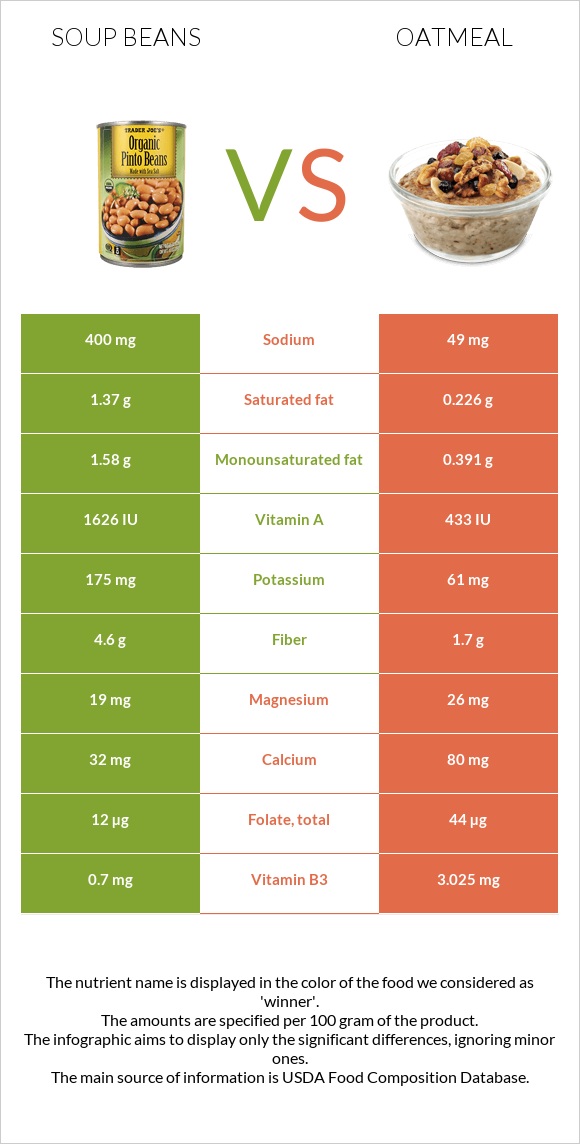Soup beans vs. Oatmeal — In-Depth Nutrition Comparison
Compare
Significant differences between soup beans and oatmeal
- Soup beans have more vitamin A, fiber, and copper; however, oatmeal is richer in iron, vitamin B6, vitamin B1, vitamin B3, vitamin B2, and manganese.
- Oatmeal covers your daily iron needs 58% more than soup beans.
- Oatmeal has 8 times less sodium than soup beans. Soup beans have 400mg of sodium, while oatmeal has 49mg.
- Oatmeal has a higher glycemic index. The glycemic index of oatmeal is 79, while the glycemic index of soup beans is 64.
Specific food types used in this comparison are Soup, bean with ham, canned, chunky, ready-to-serve and Cereals, oats, instant, fortified, plain, prepared with water (boiling water added or microwaved).
Infographic

Infographic link
Mineral Comparison
Mineral comparison score is based on the number of minerals by which one or the other food is richer. The "coverage" charts below show how much of the daily needs can be covered by 300 grams of the food.
| Contains more PotassiumPotassium | +186.9% |
| Contains more CopperCopper | +142.4% |
| Contains more SeleniumSelenium | +38% |
| Contains more MagnesiumMagnesium | +36.8% |
| Contains more CalciumCalcium | +150% |
| Contains more IronIron | +348.1% |
| Contains more ZincZinc | +40.9% |
| Contains more PhosphorusPhosphorus | +30.5% |
| Contains less SodiumSodium | -87.8% |
| Contains more ManganeseManganese | +92.4% |
Vitamin Comparison
Vitamin comparison score is based on the number of vitamins by which one or the other food is richer. The "coverage" charts below show how much of the daily needs can be covered by 300 grams of the food.
| Contains more Vitamin CVitamin C | +∞% |
| Contains more Vitamin B12Vitamin B12 | +∞% |
| Contains more Vitamin AVitamin A | +60.5% |
| Contains more Vitamin B1Vitamin B1 | +333.3% |
| Contains more Vitamin B2Vitamin B2 | +258.3% |
| Contains more Vitamin B3Vitamin B3 | +332.1% |
| Contains more Vitamin B5Vitamin B5 | +692.5% |
| Contains more Vitamin B6Vitamin B6 | +480% |
| Contains more FolateFolate | +266.7% |
All nutrients comparison - raw data values
| Nutrient |  |
 |
DV% diff. |
| Iron | 1.33mg | 5.96mg | 58% |
| Vitamin B6 | 0.05mg | 0.29mg | 18% |
| Vitamin B1 | 0.06mg | 0.26mg | 17% |
| Sodium | 400mg | 49mg | 15% |
| Vitamin B3 | 0.7mg | 3.025mg | 15% |
| Fiber | 4.6g | 1.7g | 12% |
| Manganese | 0.29mg | 0.558mg | 12% |
| Vitamin B2 | 0.06mg | 0.215mg | 12% |
| Copper | 0.16mg | 0.066mg | 10% |
| Folate | 12µg | 44µg | 8% |
| Protein | 5.19g | 2.37g | 6% |
| Vitamin B5 | 0.04mg | 0.317mg | 6% |
| Calcium | 32mg | 80mg | 5% |
| Vitamin A | 81µg | 130µg | 5% |
| Saturated fat | 1.37g | 0.226g | 5% |
| Starch | 10.37g | 4% | |
| Fats | 3.5g | 1.36g | 3% |
| Cholesterol | 9mg | 0mg | 3% |
| Potassium | 175mg | 61mg | 3% |
| Phosphorus | 59mg | 77mg | 3% |
| Selenium | 6.9µg | 5µg | 3% |
| Monounsaturated fat | 1.58g | 0.391g | 3% |
| Vitamin C | 1.8mg | 0mg | 2% |
| Magnesium | 19mg | 26mg | 2% |
| Zinc | 0.44mg | 0.62mg | 2% |
| Calories | 95kcal | 68kcal | 1% |
| Vitamin B12 | 0.03µg | 0µg | 1% |
| Choline | 4.7mg | 1% | |
| Net carbs | 6.56g | 9.97g | N/A |
| Carbs | 11.16g | 11.67g | 0% |
| Sugar | 0.46g | N/A | |
| Vitamin E | 0.07mg | 0% | |
| Vitamin K | 0.4µg | 0% | |
| Trans fat | 0.003g | N/A | |
| Polyunsaturated fat | 0.39g | 0.426g | 0% |
| Tryptophan | 0.04mg | 0% | |
| Threonine | 0.083mg | 0% | |
| Isoleucine | 0.105mg | 0% | |
| Leucine | 0.2mg | 0% | |
| Lysine | 0.135mg | 0% | |
| Methionine | 0.04mg | 0% | |
| Phenylalanine | 0.13mg | 0% | |
| Valine | 0.151mg | 0% | |
| Histidine | 0.057mg | 0% |
Macronutrient Comparison
Macronutrient breakdown side-by-side comparison
Protein:
5.19 g
Fats:
3.5 g
Carbs:
11.16 g
Water:
78.63 g
Other:
1.52 g
Protein:
2.37 g
Fats:
1.36 g
Carbs:
11.67 g
Water:
84.03 g
Other:
0.57 g
| Contains more ProteinProtein | +119% |
| Contains more FatsFats | +157.4% |
| Contains more OtherOther | +166.7% |
~equal in
Carbs
~11.67g
~equal in
Water
~84.03g
Fat Type Comparison
Fat type breakdown side-by-side comparison
Saturated fat:
Sat. Fat
1.37 g
Monounsaturated fat:
Mono. Fat
1.58 g
Polyunsaturated fat:
Poly. Fat
0.39 g
Saturated fat:
Sat. Fat
0.226 g
Monounsaturated fat:
Mono. Fat
0.391 g
Polyunsaturated fat:
Poly. Fat
0.426 g
| Contains more Mono. FatMonounsaturated fat | +304.1% |
| Contains less Sat. FatSaturated fat | -83.5% |
~equal in
Polyunsaturated fat
~0.426g





